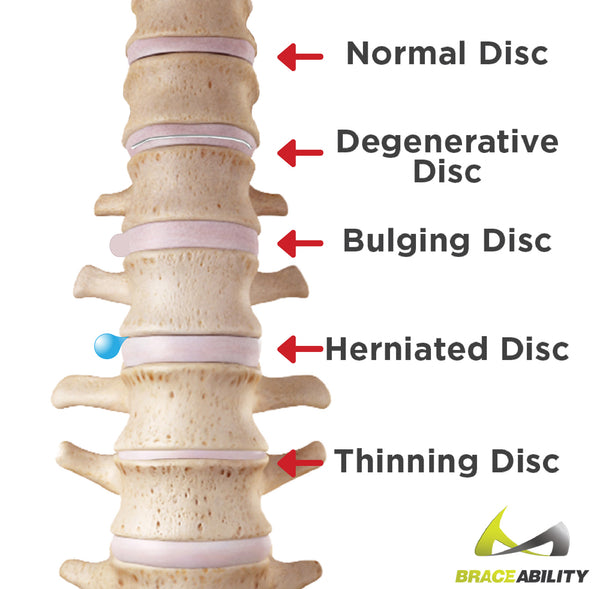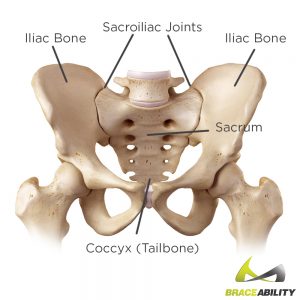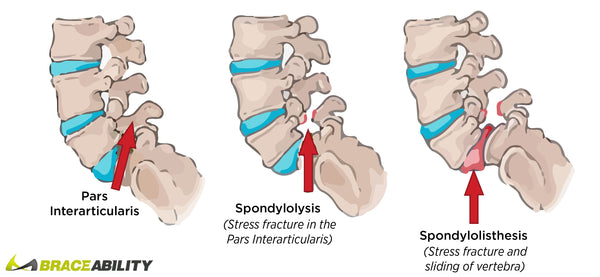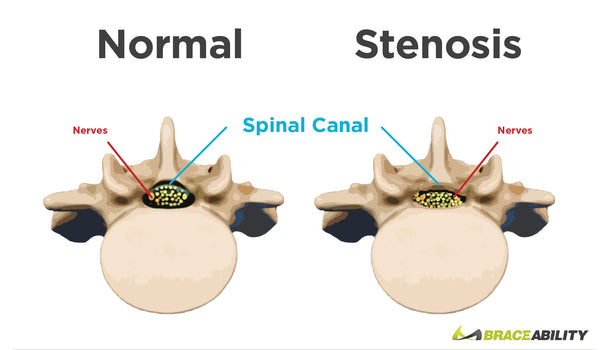What Is The Cause of My Lower Back Pain?
Many individuals suffer from some sort of lower back pain in their lifetime because of the stress and weight it holds from your upper body. The lumbar back also helps support your body while you move around, twist, and jump. All of these factors make the lower back prone to many different spinal, muscle, and ligament injuries. Continue reading below to help determine the underlying cause of your back pain and what brace is best for you!
I’m Experiencing...
- Arm or leg pain
- Numbness/tingling
- Weakness in my muscles

You Likely Have a Herniated Disc
Over time as you age, your spinal discs that were once composed of 80% water, lose some of that water content. When this occurs, your discs become less flexible, resulting in a herniated disc. A herniation in your disk is when the inner core ruptures and pushes through the crack of the outer piece.
What Brace Do I Need for a Herniated Disc?
I’m Experiencing...
- Pain in my legs/arms
- Muscle spasms
- Numbness or tingling
- Muscle stiffness
- Difficulty walking or sitting
You Likely Have Degenerative Disc Disease (DDD):
Similar to a herniated disc mentioned above, degenerative disc disease is the result of the body’s natural aging process. Degenerative disc disease (DDD) is when your discs become weak, also causing them to lose their water content. When your discs lose this water, they are less able to absorb the normal shocks your spine endures.
What Are the Best Braces for Degenerative Disc Disease?
I’m Experiencing...
- Pain in my pelvis region, legs, buttocks, and feet
- Tingling or numbing sensation
- Muscle weakness
- Muscle spasms
You Likely Have A Bulging Disc in Your Lumbar Back
A bulging disc occurs when the discs in your spine move outside its normal space. Although a bulge in your disc can occur in any region of your vertebra, It’s estimated that approximately 90 percent of bulging discs occur in the lower back (lumbar vertebra). Bulging discs commonly occur between your L4 and L5 vertebrae, and between your L5 and S1 vertebrae.
What Braces Are the Best Option for My Bulging Disc?

I’m Experiencing...
- Pain at the back of my hips
- Groin or thigh pain
- Difficulty sleeping
- Balance issues
- Stiffness or burning sensation in my pelvis
You Likely Have Si Joint Pain
Si joint severe pain is a result of too much or too little movement in your si joints. Si joint dysfunction can be a result of two things, from being unstable or stiff. Basically, this just means they’re either moving too much or too little. Sacroiliac joint dysfunction may result in your si joints becoming inflamed - leading to a condition called sacroiliitis.
What Medical Devices Do I Need for Si Joint Pain?
I’m Experiencing...
- Pain in my low back sometimes radiating to my thighs or buttocks
- Pain that worsens with exercise or high impact activities
You Likely Have Spondylolysis
Spondylolysis refers to a defect of the bones of the spine. This defect is in the pars interarticularis, which is a small, bony arch toward the back of the spine. This bone segment joins the facet joints of the spine, which can be cracked or fractured.
What Brace Do I Need Spondylolysis?

I’m Experiencing...
- Lower back pain
- Muscle spasms
- Stiffness in my back and hamstrings
- Pain, numbness, and weakness in my legs, buttocks, and hips
- Difficulty walking or running
- Pain radiating down both or one of my legs
You Likely Have Spondylolisthesis
Spondylolisthesis is when one of your bones in your vertebra slides forward (also called anterolisthesis) or backward (also called retrolisthesis) over the bone next to it. This typically occurs at the fifth or fourth vertebra of the low back, with slippage of the fifth vertebra (L5) being the most common form of lumbar spondylolisthesis
What Therapeutic Brace Do I Need for Spondylolisthesis?
- Women’s Arthritis Back Brace
- Spondylolysis Back Stabilizer
- Comprehensive LSO Spine Stabilization Brace
I’m Experiencing...
- Pain in my buttocks, hips, back, and legs
- Pain that is sometimes sharp or radiating
- Leg numbness
- Limping
You Likely Have Sciatica
Sciatica is actually a symptom of some form of nerve compression. This means that sciatica is the name for the pain that you feel (usually in your leg) because you have a pinch in the nerve in your lower lumbar back. The term “sciatica” is not an actual medical diagnosis in and of itself. Rather, it’s used to describe the symptoms (chronic leg pain) of an underlying medical problem (a pinched nerve in your back).
What Brace Do I Need for Sciatica?
I’m Experiencing...
- Acute pain, tingling, and muscle weakness in my back
- Pain that increases over time
- A hard time walking
- Clumsiness

You Likely Have Spinal Stenosis
Spinal stenosis is the narrowing of the open spaces in your spine, leading to pressure on your spinal cord and the nerves that travel through it.
What Brace Do I Need?
I’m Experiencing...
- Soreness or tenderness in my lower back
- Pain that occurs suddenly
- Muscle spasms
- Pain that increases when I walk, stand, or twist
- Pain radiating down my legs, buttock, and thigh regions
- Weakness in my muscles/tendons
- Lumbago (pain in the muscles and joints of your lower back)
You Likely Have a Muscle Strain/Tear/Pull
A sprain occurs when a ligament stretches or tears, whereas a strain occurs when a muscle or tendon stretches or tears. When you damage your muscle, part or all of the muscle fibers, and the tendons attached to those muscles are stretching too far and therefore start to tear. This tearing of your muscle damages small blood vessels, which causes bleeding or bruising, and pain because your nerve endings in that area are irritated.
What Product Do I Need?
Does Being Overweight Contribute Lower Back Pain?
Many plus size or obese individuals tend to be more prone to lower back pain and injury for many reasons. Those who are overweight carry around excess weight placing direct strain and pressure on the spine. Big individuals also tend to carry around more weight in their abdomen region, forcing the lower back to pull your body forward. This exposes your spine to injuries such as muscle strains and compression fractures. In addition, the extra weight that obese people carry around takes a toll on their spinal discs and speeds up the weakening within the vertebral discs.
Wondering if you’re considered overweight? Take our quick BMI quiz to help determine your current weight level.
Other Low Back Pain Remedies and Cures for Lower Back Pain
In addition to wearing a lower back device girdle for your chronic back pain, there are numerous things you can do to aid your condition or injury at home. Here are a few ways to treat your discomfort:
- Rest: Make sure you take the time to rest your injury, extra sleep is a good way to allow your injury time to heal. Placing a pillow underneath your back while you're resting can also help ease your pain.
- Hot/Cold Therapy: Applying heat and ice to your injury has been proven to help speed up recovery and relieve some of your pain. An easy way to apply both hot and cold to your back while also allowing you to move around is by wearing a lower back muscle pain wrap that features a pack to hold heating and cooling inserts.
- Physical Therapy: Working with a physical therapist is a great way to help your specific condition. They work to create a plan with different exercises and stretches just for you. They also have the best equipment to help your injury!
- Anti-Inflammatory Medications: Medicines help reduce the swelling while also providing pain relief.
- Low Back Pain Exercises: Exercises that emphasize your core and stomach area help take the stress off of your spine and back.
- Wall sit
- Bridge
- Press up
- Plank
- Low Back Pain Stretches:
- Knee to chest stretch
- Double knee to chest
- Hip stretch
- Cat/cow stretch
- Correcting Posture: Lower/mid back pain can also be a result of having poor posture because it forces your spine to hold your shoulders and arms up in the right position. Wearing a posture brace is an easy and great tool to help straighten up your muscles. We also have an obesity posture brace for those needing a larger size. Although this posture brace may help to some extent, individuals that have lordosis or scoliosis (different forms of posture), may need a more complex brace such as our postural extension back brace.




















